Xiangshuihu Great Wall
The Xiangshuihu Great Wall is located in Huairou District, Beijing, to the west of the Mutianyu Great Wall and the Jiankou Great Wall, about 80 kilometers (50 miles) from the city center. Renowned for its breathtaking perilousness, it features two “straight ladders” with near-90-degree slopes. The height between steps exceeds the height of a calf, posing a considerable challenge to climbers.
“Xiangshuihu” literally means a lake with a particularly loud sound in Chinese. However, the name “Xiangshuihu” doesn’t stem from a lake. Instead, at the spring’s source, water gushes out powerfully, creating a thunderous sound that can be heard from a kilometer away, thus earning it this name.
The Xiangshuihu Great Wall is part of the Xiangshuihu Scenic Area. The area integrates the Ming Dynasty (1368 - 1644) Great Wall, springs, waterfalls, ancient caves, and cliff carvings, making it a unique and charming tourist and leisure destination.
|
|
What to See in Xiangshuihu?
1. Moshikou Pass
Moshikou Pass is the entrance to the Xiangshuihu Great Wall. Literally meaning “a pass smoothed by grinding,” Moshikou Pass got its name because a stream once flowed beneath it, eroding the pass’s bedrock. In ancient times, the pass was also called “Double Passes” because it was composed of two defensive structures: one tower and one barbican, together with the stream, forming a strong defense that was hard to break through.
2. Jade Watchtower
Constructed entirely of white marble, including its foundation, arches, arrow windows, and steps, the Jade Watchtower is a miracle. Three stone slabs above the east and west arches are adorned with cloud patterns, while the remaining four, two horizontal and two vertical, are engraved with water patterns. The interior is more than a simple passageway; it features a large central hall, reminiscent of a general’s office. On the side wall of second-floor, a complete archway remains intact, which is rather rare. As a result, it stands out prominently among the mountains, offering a magnificent sight both from afar and up close.
3. Health Preserving Valley
Spanning 2.5 kilometers (1.6 miles), the Health Preserving Valley is filled with health preservation maxims of ancient famous physicians, secret prescriptions engraved on stones, and hundreds of medicinal herbs. The valley’s scenery is captivating, with towering waterfalls, clear springs, a glittering river, chirping birds, fragrant flowers, and fresh air, providing a sense of relaxation and joy.
How to Tour the Xiangshuihu Great Wall?
 |
| Hiking on the Xiangshuihu Great Wall |
- After visiting, return to the Great Wall entrance along the same route. Then, take the shuttle bus or walk about one kilometer (0.6 miles) back to the scenic area entrance.
Note: If you are interested in traditional Chinese medicine or herbal remedies, you can take a stroll in the Health Preserving Valley after hiking the Xiangshuihu Great Wall. It is only 200 meters (220 yards) from the entrance of the Xiangshuihu Great Wall. A round trip in the Health Preserving Valley is about 5 kilometers (3 miles) and takes approximately 1.5 to 2 hours. After the visit, you can take the shuttle bus at the entrance of the Health Preserving Valley back to the entrance of the scenic area.
Opening Hours:
| Feb. 10 - Nov. 15 | 08:00 - 17:00 |
| Nov. 16 - Feb. 9 | 08:00 - 16:00 |
Tickets:
| Entrance fee | CNY 43 Children under 6 years old are free of charge; Students and seniors enjoy half price. |
| Shuttle bus | CNY 10 for one-way Free for children under 1 meter (3.3 feet) |
When is the Best Time for a Visit?
How to Get to Xiangshuihu Great Wall from Beijing?
1. By bus: 916 + H34; 3 hours; CNY 19
Bus schedule:
| Bus 916 Express | From Dongzhimen: 05:50 - 20:00 Return to Dongzhimen: 04:30 - 18:50 |
| Bus H34 | Get to Xiangshuihu: 06:45 - 16:00 From Xiangshuihu: 08:00 - 17:15 |
2. Taxi or car rental: 1.5 - 2 hours, CNY 800 - 1,200 per day
Notes and Tips:
2. Many sections require the use of hands and feet. It is better to wear non-slip shoes and gloves.
3. There are shops and restaurants in the scenic area, but the price is relatively high. It is recommended to bring some food and water with you.
You may like:
Beijing Great Wall
Recommended Tours
- Last updated on Apr. 11, 2025 by Sherry Xia -

